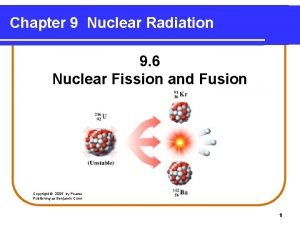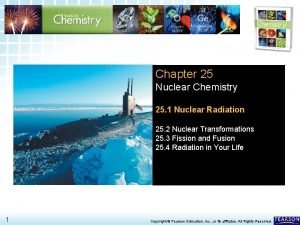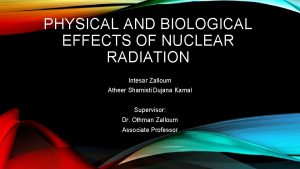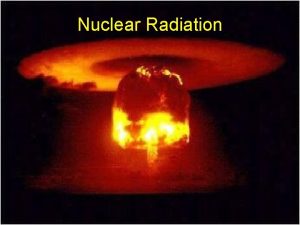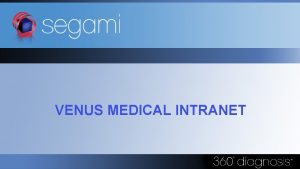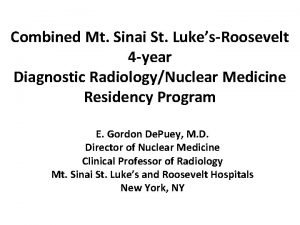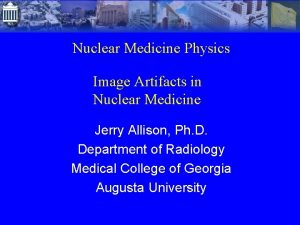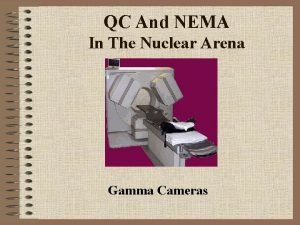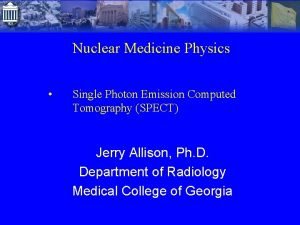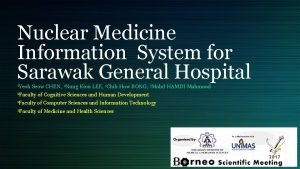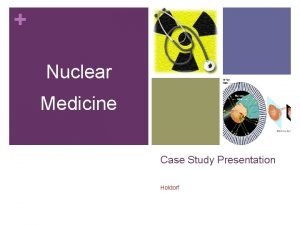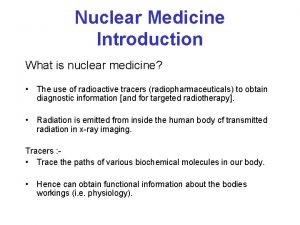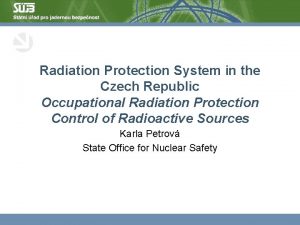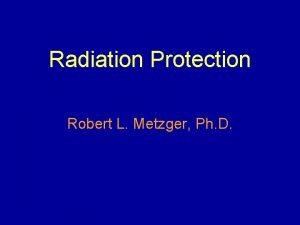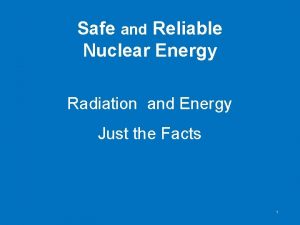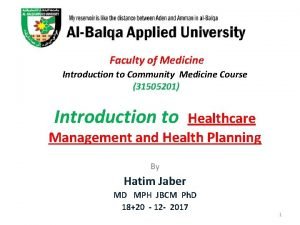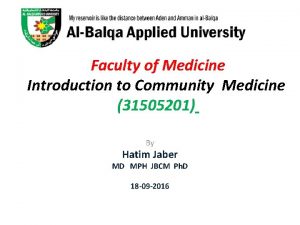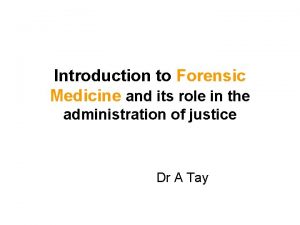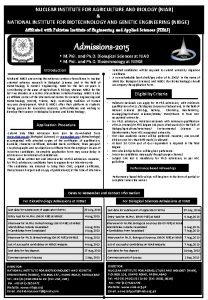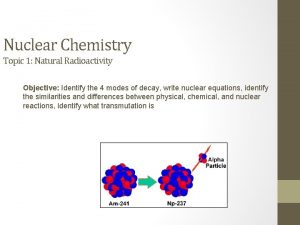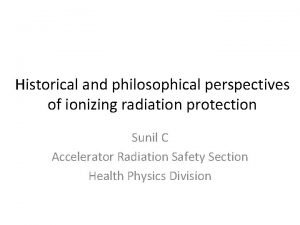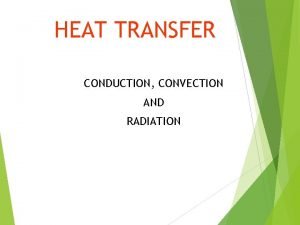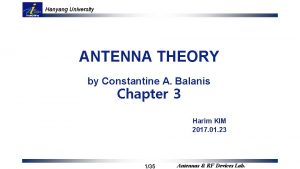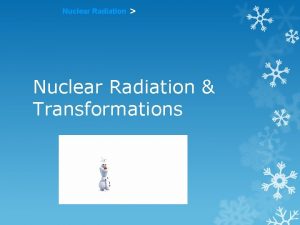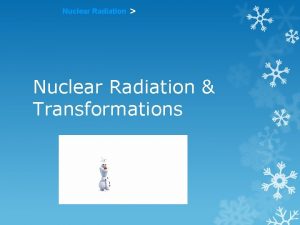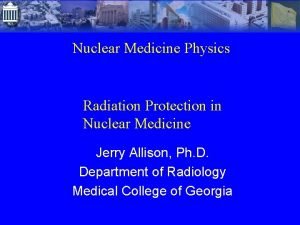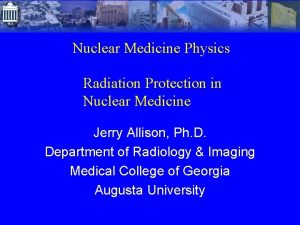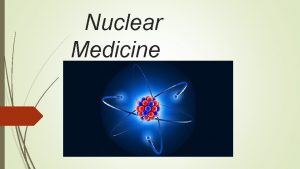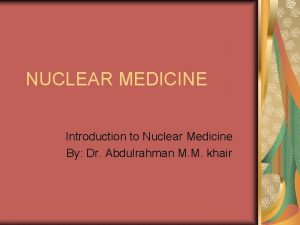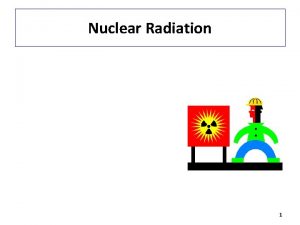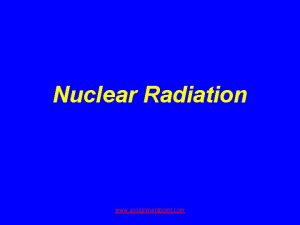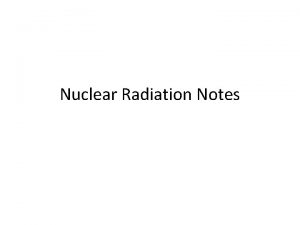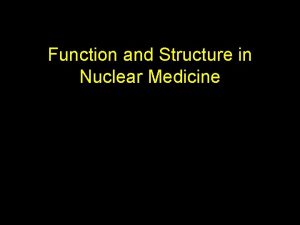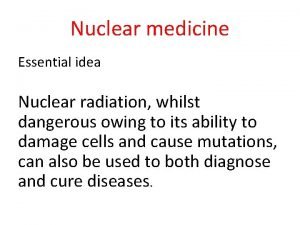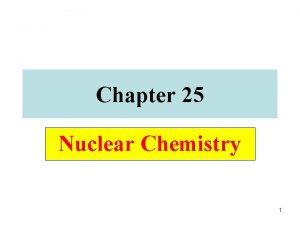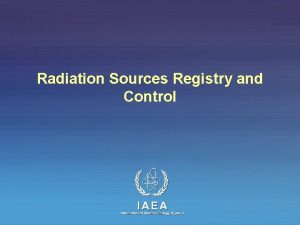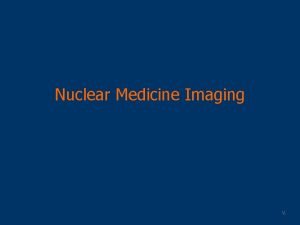Radiation Sources in Nuclear Medicine Introduction Sources and











































![Calibration of Equipment and Sources [GSR Part 3 Requirement 38, 3. 166] The medical Calibration of Equipment and Sources [GSR Part 3 Requirement 38, 3. 166] The medical](https://slidetodoc.com/presentation_image_h/7f26fe1a2ba36577780d3bc0dba88510/image-44.jpg)

- Slides: 45

Radiation Sources in Nuclear Medicine Introduction, Sources and Equipment IAEA International Atomic Energy Agency Day 7 – Lecture 7

Objective To understand the uses of radiopharmaceuticals and equipment used in nuclear medicine. IAEA 2

Contents • • Introduction to Nuclear Medicine, Objectives of Nuclear Medicine, Most commonly used radionuclides Equipment used. IAEA 3

“Introduction to Nuclear Medicine” IAEA International Atomic Energy Agency

What is nuclear medicine? Nuclear medicine: • is a medical specialty that uses radioactive materials to both diagnose the body and treat disease; • documents organ function and structure; • uses relatively small amounts of radioactive materials (radiopharmaceuticals) to diagnose and treat which are substances that are localized in specific organs, bones, or tissues; IAEA 5

What is nuclear medicine? (cont) • Most radiopharmaceuticals used in nuclear medicine procedures can be detected externally using special detectors e. g. gamma cameras, PET scanners. • Cameras work in conjunction with computers to form images that provide data and information about the organ or area of body being imaged. • The radiation dose received from a diagnostic nuclear medicine procedure is comparable to that received from some diagnostic x-ray examinations. IAEA 6

What is nuclear medicine? (cont) There are nearly 100 different nuclear medicine imaging procedures in use today, including: • diagnosis and treatment of hyperthyroidism; • • cardiac stress tests to analyze heart function; bone scans for metastatic growths; lung scans for blood clots; kidney, liver and gall bladder procedures to diagnose abnormal function or blockages. IAEA 7

Diagnosis and Therapy with Unsealed Sources Define clinical problem Choose radiopharmaceutical IAEA Select Instrumentation

Objectives of Nuclear Medicine For diagnostic procedures, the objective is to • obtain clinical data regarding the distribution of : radiopharmaceuticals that reflect a combination of blood flow, capillary permeability and tissue extraction, and • record images of the activity distribution to determine organ function (e. g. determine cerebral blood flow, ventricular function, thyroid uptake). For therapeutic procedures, the objective is • to administer a prescribed radiation dose to the target tissue to obtain the desired effect (e. g. reduce tumor size). IAEA 9

Commonly Used Radionuclides IAEA International Atomic Energy Agency

Commonly used Radiopharmaceuticals • The primary radionuclide used for diagnostic nuclear medicine procedures is Technetium-99 m (99 m. Tc). • The primary radionuclide used for therapeutic nuclear medicine procedures is Iodine-131 (131 I). IAEA 11

Radiopharmaceutical Generators Radiopharmaceutical generators: • are constructed on the principle of the decay-growth relationship between a long-lived parent and its short-lived daughter radionuclide. q i. e. a long-lived parent nuclide is allowed to decay to its short-lived daughter nuclide and the latter is then chemically separated. e. g. 99 Mo (T½ = 66. 6 hours) 99 m. Tc (T½ = 6 hours) IAEA 12

Radiopharmaceutical Generators (cont) The importance of generators lies in the fact that they: • are easily transportable; and • can serve as sources of short-lived radionuclides in institutions located in remote areas where contracting the services of a radiopharmacy is impracticable. IAEA 13

Technetium 99 m. Tc has the very favorable physical and radiation characteristics of: - • a 6 hour physical half-life; • the absence of β radiation permits the administration of GBq activities for diagnostic purposes without significant radiation dose to the patient; • emits 140 ke. V photons which can be readily collimated to give images of superior spatial resolution; • Is readily available in a sterile, pyrogen free and carrier free state from 99 Mo - 99 m. Tc generators. IAEA

Technetium 99 m. Tc labeled radiopharmaceuticals are easily produced by simply adding 99 m. Tc. O 4 to many choices of “cold kits”. IAEA 15

Technetium 99 m (cont) In short, 99 m. Tc. O 4 is added to a vial containing a chemical compound that binds to the radionuclide. The result is a radiopharmaceutical which will be taken up in the designated organ for imaging (or analysis) with a gamma camera. IAEA 16

Iodine 131 Iodine: • is produced in a reactor; • is used in diagnostic procedures involving the thyroid and also for the treatment of thyroid disorders; • can be administered in capsule or liquid solution form; • requires special precautions to be implemented during administration. IAEA 17

Other Radionuclides The production of other radionuclides for nuclear medicine (e. g. PET) involves the use of a cyclotron. Medical Cyclotron IAEA Industrial cyclotron 18

Principles of Uptake (localization) A radiopharmaceutical: • has two components; a radionuclide and a pharmaceutical. In designing a radiopharmaceutical, a pharmaceutical is first chosen on the basis of its preferential uptake (localization) by a given organ or its participation in the physiological function of the organ i. e. the morphology and / or the physiology of the organ can be assessed. IAEA 19

Calculating the Required Activity (cont) The technologist must: • determine the volume of the radiopharmaceutical to draw into the syringe; • because of the short half life of 99 m. Tc, calculate the specific concentration of the radiopharmaceutical at the time of administration, e. g. a 10 ml solution containing 1. 85 GBq will have a concentration of 0. 185 GBq/ml. • can then use the specific concentration and the decay constant for 99 m. Tc, to calculate the exact volume to be drawn up for the prescribed activity to be administered. He also must measure the activity of each dose prior to use IAEA

“Equipment Used in Nuclear Medicine” IAEA International Atomic Energy Agency

Categories of Equipment Important to Radionuclide Imaging: • Activity Meters (also known as Dose Calibrators) • Counting Equipment • Monitoring Equipment • Imaging Equipment IAEA

Equipment Categories Dose (activity) calibrator A dose (or activity) calibrator measures the quantity of radioactive material in the prepared radiopharmaceutical prior to administration to the patient. IAEA 24

Counting Equipment • Several types of counting equipment are used in Nuclear Medicine including ionization chambers, proportional counters, GM- tubes and scintillation detectors. • used for various tasks including ambient dose-rate survey monitoring, surveys for removeable contamination, sample counting and bioassay measurements. IAEA 25

Monitoring (counting and survey) Equipment IAEA

Non-imaging Counting Devices Mainly used for counting during thyroid uptake studies. IAEA

Non-imaging Counting Devices (cont) Scintillation Well Counters are used: - • mainly to count blood and urine samples. • to count wipe test samples to identify if radioactive contamination exists in the area surveyed. IAEA

Imaging Equipment Following administration of the radiopharmaceutical to the patient, a gamma camera is used to image the area of interest. IAEA 29

Gamma Cameras Gamma cameras are used to show the radiopharmaceutical distributes itself throughout the body or is taken up by specifically targeted organs. IAEA 30

Gamma Cameras (cont) IAEA 31

Gamma Cameras (cont) In most cases, gamma cameras are interfaced with a computer which controls data acquisition, processing and image display. IAEA 32

Gamma Cameras (cont) Still and dynamic images can be acquired Tomographic Dynamic Static IAEA 33

SPECT Imaging Single Photon Emission Computed Tomography • SPECT cameras looks at a patient from many different angles and is able to demonstrate very precise detail within the patient. • Information is presented as a series of planes that correspond to certain depths within the body. • The planes presented may be a series of coronal, sagittal, transverse and / or oblique slices. IAEA 34

SPECT Imaging (cont) IAEA 35

Rectilinear Scanners Early scintillation imaging devices IAEA Rollo 1977 36

PET Scanners Positron Emission Tomography (PET) is used to study physiologic and biochemical processes within the body • Processes studied include blood flow, oxygen, glucose and fatty acid metabolism, amino acid transport, p. H and neuroreceptor densities. • An on-site cyclotron is required to produce the very short half life PET radiopharmaceuticals. IAEA 37

PET Scanners (cont) IAEA 38

Mobile PET Scanner IAEA 39

Personal Monitoring For any worker who usually works in a controlled area, and may receive a significant dose from occupational exposure, individual monitoring shall be undertaken where appropriate, adequate and feasible. [GSR Part 3 Requirement 25, 3. 100] IAEA 40

Personal Monitoring (cont) Doses from External Radiation • Thermoluminescent (TLD) or Optically Stimulated Luminescence (OSL) dosimeter q gamma, X and beta radiation • Film dosimeter q IAEA gamma, X and beta radiation 41

Personal Monitoring (cont) Doses from External Radiation (cont) Electronic dosimeter, with or without alarm Film badge, electronic dosimeter, ring badge, TLD IAEA 42

Personal Monitoring (cont) Assessing Doses from Internal Radiation • Urinalysis. • Whole body monitor: q gamma emitting radioisotopes. • Thyroid monitoring: q iodine radioisotopes. IAEA 43

Personal Monitoring (cont) Record Keeping • • Employers and licensees shall maintain exposure records for each monitored worker. Records are to be maintained as required by the Regulatory Body. Information is confidential and must be kept secure. Access to records shall be provided to: q the relevant worker; q relevant employer; q Regulatory Body; q health surveillance professionals IAEA 44
![Calibration of Equipment and Sources GSR Part 3 Requirement 38 3 166 The medical Calibration of Equipment and Sources [GSR Part 3 Requirement 38, 3. 166] The medical](https://slidetodoc.com/presentation_image_h/7f26fe1a2ba36577780d3bc0dba88510/image-44.jpg)
Calibration of Equipment and Sources [GSR Part 3 Requirement 38, 3. 166] The medical physicist shall ensure that: (a) All sources giving rise to medical exposure are calibrated in terms of appropriate quantities using internationally accepted protocols; (b) calibrations are carried out at the time of commissioning a unit prior to the clinical use, after any maintenance procedure that could affect the dosimetry and at intervals approved by the Regulatory Body. IAEA 45

References • Radiation Protection and Safety of Radiation Sources: International Basic Safety Standards. Generic Safety Requirements. GSR Part 3 (Interim) Vienna (2011) • Regulatory Control of Radioactive Sources, Safety Standards Series No. GS-G-1. 5, IAEA, Vienna (2004) • Notification and Authorization for the Use of Radiation Sources. IAEATECDOC-1525. Vienna, 2007 IAEA 46
 Lesson 15 nuclear quest nuclear reactions
Lesson 15 nuclear quest nuclear reactions Fisión nuclear vs fision nuclear
Fisión nuclear vs fision nuclear Nuclear fusion radiation
Nuclear fusion radiation Types of radiation
Types of radiation What is nuclear radiation
What is nuclear radiation Nuclear radiation
Nuclear radiation Intranet venus
Intranet venus Mt sinai nuclear medicine
Mt sinai nuclear medicine Diaphragm
Diaphragm Nuclear medicine lectures
Nuclear medicine lectures Edge packing
Edge packing Filtered back projection
Filtered back projection Nuclear medicine information system
Nuclear medicine information system Medical case study presentation
Medical case study presentation Spatial resolution
Spatial resolution Ionizing radiation sources
Ionizing radiation sources Ionizing radiation sources
Ionizing radiation sources Natural sources of radiation
Natural sources of radiation Print sources and web sources
Print sources and web sources Water management importance
Water management importance Introduction to community medicine
Introduction to community medicine Concepts of health and disease
Concepts of health and disease Introduction to forensic medicine
Introduction to forensic medicine Natural transmutation example
Natural transmutation example Quantum and nuclear physics
Quantum and nuclear physics Cons of electricity
Cons of electricity Conjugal family
Conjugal family Nuclear decays and reactions section 2
Nuclear decays and reactions section 2 Nuclear institute for agriculture and biology
Nuclear institute for agriculture and biology Nuclear fission and fusion similarities
Nuclear fission and fusion similarities Kaist nuclear engineering
Kaist nuclear engineering Sun fission
Sun fission Advantage and disadvantage of single parent family
Advantage and disadvantage of single parent family Fission vs fusion
Fission vs fusion Neutron emission
Neutron emission Fussion vs fission
Fussion vs fission Key terms radioactivity and nuclear reactions
Key terms radioactivity and nuclear reactions Fission v fusion
Fission v fusion Conduction or convection
Conduction or convection Greenhouse effect long and shortwave radiation
Greenhouse effect long and shortwave radiation Solid to gas examples
Solid to gas examples For parents and friends radiation threat
For parents and friends radiation threat Ionizing radiation examples
Ionizing radiation examples What is heat transfer conduction convection and radiation
What is heat transfer conduction convection and radiation Compare and contrast conduction and convection
Compare and contrast conduction and convection Duality theorem in antenna
Duality theorem in antenna


